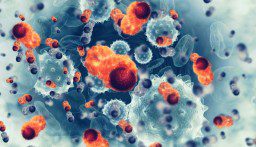Muna Februaryry 2023, a phase 1 trial at a single institution found that it was safe and possible for people with heavily pretreated large B-cell lymphoma (LBCL) to use CD22-directed chimeric antigen receptor (CAR) T-cell therapy after relapse on CD19-directed CAR T-cell kurapa. In addition, patients exhibited high overall response rates (ORRs), and complete responses (CRs) in these patients were found to be durable.
A presentation by lead study author Matthew J. Frank, MD, PhD, assistant professor of medicine in the Division of Bone Marrow Transplant & Cellular Therapy at the Stanford Cancer Institute, said, “A single infusion of CAR22 produced high response rates in heavily pretreated large B-cell lymphoma patients who relapsed after CAR19.” Frank is the director of the study and an assistant professor of medicine.
CD19-directed CAR T-cell kurapa has led to significant responses in patients with relapsed/refractory LBCL; however, if relapse occurs, patients have a very poor prognosis, and many exhibit CD19 loss or reduced expression.
Frank akati, “Pane kushomeka kwemishonga inorapa inopiwa kana munhu atangazve.” Tichifunga nezvehurombo hwekufungidzira kwevarwere vanodzokera shure mushure mekugamuchira carnitine marapirwo, pane kukurumidza kusingagutsikane kudiwa kwenovel therapies.
CD22 is of interest as a target for CAR T-cell therapy as it can be found on the surface of malignant B cells in 95% of B-cell acute lymphoblastic leukaemias (ALLs) and LBCLs. CD22-directed CAR T-cell therapy has already demonstrated high response rates in patients with heavily pretreated ALL.
Adults with B-cell ALL and B-cell isiri-Hodgkin lymphoma were enrolled in the dose-escalation phase 1 study of CAR T-cell therapy directed at CD22. Frank presented at the Tandem Meetings the results of the LBCL cohort.
All patients in the cohort had relapsed/refractory LBCL, including diffuse LBCL not otherwise specified, transformed follicular lymphoma, marginal zone lymphoma, chisingaperi lymphocytic leukemia/small lymphocytic lymphoma, primary mediastinal B-cell lymphoma, and secondary central nervous system involvement. In addition, patients were resistant to CD19-directed CAR T-cell therapy or had CD19-negative disease in conjunction with any CD22 expression. Patients who had previously received CAR T-cell therapy had to have at least 30 days passed since their last infusion and less than 5% CAR-positive cells in their peripheral blood, according to flow cytometry.
Patients received either 1 x 106 (dose level 1) or 3 x 106 (dose level 2) of the CD22-targeted drug (dose level 2). Prior to infusion, patients received intravenous fludarabine (30 mg/m2) and cyclophosphamide (500 mg) to administer lymphodepleting chemotherapy.
The primary objectives of the study were manufacturing feasibility, the phase 2 dose recommendation, safety, and toxicity. The investigator-assessed ORR, duration of response, progression-free survival (PFS), overall survival (OS), CAR T associated toxicity, CD22 antigen expression, CAR-positive cell levels in the blood, and serum cytokine profiling were secondary endpoints.
Pakati pevarwere vane 41 vakanyoresa, CAR T-cell chigadzirwa chakabudirira kugadzirwa kwe38 (95%), sezvo 2 yakanga isina kukwana T masero e leukapheresis. Avhareji yenguva pakati peleukapheresis uye infusion yaive mazuva gumi nemasere.
The median age of participants who received CAR T-cell therapy was 65 (range, 25-84), they had an ECOG performance status of 0 or 1, and they had received a median of 4 prior lines of therapy (range, 3-8). 74% of patients had diffuse LBCL, and 21% had transformed follicular lymphoma. 39% of patients were diagnosed with non-germinal centre B-cell-like disease, and 18% had double-hit status. 97% of patients had previously received CD19-directed CAR T-cell therapy, and 18% had previously undergone autologous hematopoietic stem cell transplantation. 29 percent of patients did not achieve a CR to any prior therapy.
Iyo yepakati yekutevera nguva yevarwere vese yaive mwedzi 18.4 (range: 1.5-38.6), panguva iyo ORR yaive 68% uye CR rate yaive 53%. Iyo yepakati PFS yaive mwedzi 2.9 (95% nguva yekuvimba [CI], 1.7-NR) uye yepakati OS yaive 22.5 mwedzi (95% CI, 8.3-NR).
Payero yezinga 1 (n = 29), varwere vakateverwa kwepakati pemwedzi 14.1 (range, 1.5-38.6), kuratidza 66% ORR uye 52% CR chiyero. Kupona kweMedhia-yemahara yaive mwedzi 3.0 (95% CI, 1.6-NR) uye yepakati kupona kwese kwaive NR (95% CI, 8.3-NR).
Payero yedosi 2 (n = 9), iyo yepakati yekutevera yaive mwedzi 27.1 (renji: 24.7-33.5), iyo ORR yaive 78%, uye CR rate yaive 55%. Iyo yepakati PFS yaive mwedzi 2.6 (95% nguva yekuvimba: 1.3-NR) uye yepakati OS yaive mwedzi 22.5 (95% nguva yekuvimba: 5.5-NR).
Mumwe chete wevarwere makumi maviri vakawana CR akange adzokera kumashure seyekuchekwa kwedata, zvichiratidza kuti maCR anogara. Pakasvika mwedzi wechitatu, varwere vose vakanga vafambira mberi pakurapwa vakanga vazviita.
In 95% of patients, cytokine release syndrome was observed, with grade 1 events occurring in 37%, grade 2 in 55%, and grade 3 in 3%. 8% of patients experienced neurologic events of grade 1 severity, while 5% experienced events of grade 2 severity. 18% of patients also reported toxicity resembling hemophagocytic lymphohistiocytosis.
Mumwe murwere padanho rechipiri akafa ne sepsis pazuva re2, uye mumwe murwere akagadzira kurapa kwakabatana nemyelodysplasia / acute myeloid leukemia pasina uchapupu hweLBCL inodzokazve mwedzi 40 mushure mokugamuchira CD11-inotungamirirwa nemishonga.
Chiyero chakakurudzirwa chechikamu chechipiri chakatemerwa kuve 2.
Ruzivo rwakamboburitswa rwaitsanangura marapirwo evarwere vatatu vekutanga.
Vese varwere vaviri vaive nehunhu hwakanyanya uye vakagamuchira mitsetse mishanu yekurapa isati yasvika, kusanganisira CD19-inotungamirwa neCAR T-cell therapy. Mumwe wevarwere akambowana marapiro maviri eCAR T-cell, wechipiri akananga CD19 neCD20. Vose varwere vatatu vakawana CR, nemurwere 3 achiwana CR pazuva 28. CRs dzakachengetwa kwemakore anopfuura matatu.
Frank akataurawo kuti "kupararira kweCAR22 kwakapetwa kagumi uye kunoramba kuchienderera mberi kupfuura CAR19."
To learn more about patients who have relapsed after CD19-directed CAR T-cell therapy, a planned multicenter phase 2 trial of this agent is being set up. The trial will likely begin this summer.
References
1. Frank MJ, Sahaf B, Baird J, et al. CD22 CAR T cell therapy induces durable remissions in patients with large B cell lymphoma who relapse after CD19 CAR T cell therapy. Presented at: 2023 Transplantation & Cellular Therapy Meetings of ASTCT and CIBMTR; February 15-19, 2023; Orlando, FL. Abstract 2.
2. Baird JH, Frank MJ, Craig J, nevamwe. CD22-inotungamirirwa neCAR T-cell therapy inokonzera kuregererwa kwakakwana muCD19-inotungamirirwa neCAR-refractory yakakura B-cell lymphoma. Ropa. 2021;137(17):2321-2325. doi:10.1182/blood.2020009432


